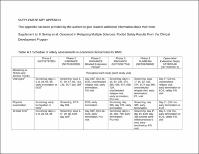| dc.contributor | Vall d'Hebron Barcelona Hospital Campus |
| dc.contributor.author | Selmaj, Krzysztof W. |
| dc.contributor.author | Cohen, Jeffrey A |
| dc.contributor.author | Comi, Giancarlo |
| dc.contributor.author | Arnold, Douglas L |
| dc.contributor.author | Steinman, Lawrence |
| dc.contributor.author | Montalban, Xavier |
| dc.contributor.author | Bar-Or, Amit |
| dc.date.accessioned | 2022-02-24T16:27:50Z |
| dc.date.available | 2022-02-24T16:27:50Z |
| dc.date.issued | 2021-06 |
| dc.identifier.citation | Selmaj KW, Cohen JA, Comi G, Bar-Or A, Arnold DL, Steinman L, et al. Ozanimod in relapsing multiple sclerosis: Pooled safety results from the clinical development program. Mult Scler Relat Disord. 2021 Jun;51:102844. |
| dc.identifier.issn | 2211-0348 |
| dc.identifier.uri | https://hdl.handle.net/11351/7079 |
| dc.description | Adverse events; Multiple sclerosis; Ozanimod |
| dc.description.abstract | Background
Ozanimod, an oral sphingosine 1-phosphate receptor 1 and 5 modulator, is approved in multiple countries for the treatment of relapsing multiple sclerosis (RMS). In phase 3 trials, ozanimod was well tolerated and superior to interferon beta-1a 30 µg once-weekly in reducing clinical and radiologic disease activity. The objective of this integrated safety analysis was to evaluate the safety of extended ozanimod exposure in participants with RMS from all clinical trials and compare it with phase 3 trial data.
Methods
We report pooled incidence and study duration‒adjusted incidence rates (IR) of treatment-emergent adverse events (TEAEs) from an interim data cut (January 31, 2019) of RMS participants treated with ozanimod. Data were pooled from a phase 1 pharmacokinetic/pharmacodynamic trial, a placebo-controlled phase 2 trial with dose-blinded extension, 2 large active-controlled phase 3 trials, and an open-label extension (OLE). Results were compared with pooled phase 3 trial data.
Results
At the data cutoff, 2631 RMS participants had exposure to ozanimod 0.92 mg (mean 32.0 months) and 2787 had exposure to either ozanimod 0.46 or 0.92 mg (mean 37.1 months). The IRs per 1000 person-years (PY) for any TEAE (772.2) and serious TEAEs (33.2) in the overall population were similar to those in the phase 3 population (896.1 and 31.2, respectively). There were no serious opportunistic infections. There were no second-degree or higher atrioventricular blocks on electrocardiogram. Hepatic enzyme elevations declined over time. Malignancy rates remained low with longer exposure. Pulmonary function tests showed minimal reductions in lung function. Seven ozanimod-treated participants with comorbid risk factors had confirmed macular edema, including 3 in the ongoing OLE.
Conclusions
Safety results in this larger RMS population with greater ozanimod exposure demonstrated no new safety concerns and were consistent with phase 3 trial results. |
| dc.language.iso | eng |
| dc.publisher | Elsevier |
| dc.relation.ispartofseries | Multiple Sclerosis and Related Disorders;51 |
| dc.rights | Attribution 4.0 International |
| dc.rights.uri | http://creativecommons.org/licenses/by/4.0/ |
| dc.source | Scientia |
| dc.subject | Esclerosi múltiple - Tractament |
| dc.subject | Avaluació de resultats (Assistència sanitària) |
| dc.subject.mesh | Multiple Sclerosis, Relapsing-Remitting |
| dc.subject.mesh | /drug therapy |
| dc.subject.mesh | Treatment Outcome |
| dc.title | Ozanimod in relapsing multiple sclerosis: Pooled safety results from the clinical development program |
| dc.type | info:eu-repo/semantics/article |
| dc.identifier.doi | 10.1016/j.msard.2021.102844 |
| dc.subject.decs | esclerosis múltiple recurrente-remitente |
| dc.subject.decs | /farmacoterapia |
| dc.subject.decs | resultado del tratamiento |
| dc.relation.publishversion | https://doi.org/10.1016/j.msard.2021.102844 |
| dc.type.version | info:eu-repo/semantics/publishedVersion |
| dc.audience | Professionals |
| dc.contributor.organismes | Institut Català de la Salut |
| dc.contributor.authoraffiliation | [Selmaj KW] Center for Neurology, 90-324 Łódź, Poland and Collegium Medicum, Department of Neurology, University of Warmia and Mazury, 11-082 Olsztyn, Poland. [Cohen JA] Department of Neurology, Mellen Center for MS Treatment and Research, Neurological Institute, Cleveland Clinic, Cleveland, Ohio, 44195, USA. [Comi G] Department of Neurology, San Raffaele Scientific Institute, Vita-Salute San Raffaele University, 20132 Milan, Italy. [Bar-Or A] Center for Neuroinflammation and Experimental Therapeutics, and Department of Neurology, Perelman School of Medicine, University of Pennsylvania, Philadelphia, Pennsylvania, 19104, USA. [Arnold DL] NeuroRx Research and Montréal Neurological Institute, McGill University, Montreal, Quebec, H3A 2B4, Canada. [Steinman L] Department of Neurology and Neurological Sciences, Beckman Center for Molecular Medicine, Stanford University Medical Center, Stanford, California 94305, USA. [Montalban X] Servei de Neurologia-Neuroimmunologia, Centre d’Esclerosi Múltiple de Catalunya (CEMCAT), Barcelona, Spain. Vall d’Hebron Hospital Universitari, Barcelona, Spain |
| dc.identifier.pmid | 33892317 |
| dc.identifier.wos | 000689354300026 |
| dc.rights.accessrights | info:eu-repo/semantics/openAccess |

 Private area
Private area Contact Us
Contact Us








